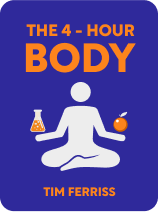

This article is an excerpt from the Shortform book guide to "The 4-Hour Body" by Timothy Ferriss. Shortform has the world's best summaries and analyses of books you should be reading.
Like this article? Sign up for a free trial here .
What is Tim Ferriss’s advice about powerlifting in The 4-Hour Body? Is there a beginner’s guide to powerlifting?
In The 4-Hour Body, Tim Ferriss trained with an elite powerlifting coach. His experience serves as a guide to powerlifting.
Read on for a guide to powerlifting informed by the training Tim Ferriss went through in The 4-Hour Body.
Guide to Powerlifting
Powerlifting is the second of five sports that the author self-experimented with. He trained with Marty Gallagher, an elite powerlifting coach, to add 100 pounds to his bench press in 12 weeks. You can use the same program to improve your bench press too.
There are two steps in the beginner’s guide to powerlifting:
Step #1: Learn Proper Bench Pressing Technique
You’ll use Mark Bell’s form to bench press. Mark is 275 pounds and can press 854 pounds. His form is safe for beginners and intermediates, so this is a beginner’s guide to powerlifting exercise. To press:
- Use a power rack or find a partner who can act as a spotter. Never bench press free weights by yourself.
- Lie on the bench on your back. Place your head half off the bench.
- Put your hands on the bar and grip it. There are three kinds of grips and you’ll use all of them in Step #2:
- Power grip. This grip is the placement of your hand that allows you to lift the most. If you’re between 5’6” and 5’9”, your hands will probably be around one hand-width in from the smooth rings on an Olympic barbell. If you’re between 5’10” and 6”, your hands will probably be just inside the smooth rings.
- Wide grip. This grip is two hand-widths wider than the power grip.
- Narrow grip. This grip is two hand-widths narrower than the power grip.
- Pull your chest up to the bar. Pull your shoulders back like you’re squeezing something between your shoulder blades.
- Maintain that shoulder position. Then, arch your back and press your shoulders down towards your feet.
- Lower your back to the bench. The top of your head should now be fully on the bench.
- Tense your legs and glutes hard. Your toes should be pressing into your shoes.
- Ask your spotter to help you lift the bar out of its cradle and place it above your chest, right above your nipples.
- Lower your shoulders, keeping your arms straight. This will decrease the distance you have to move the weight.
- Grip the bar hard and bend your arms to lower the weight towards your breastbone. During the bottom half, pull your elbows closer to your sides.
- Push the bar straight back up. You can open your elbows a little in the top half if you need to.
Step #2: Follow a Three-Phase Program
There are two rules for this part of the guide to powerlifting exercises:
- Don’t ever miss a workout session.
- You’ll have to add muscular body weight as you carry out the plan. You need more muscle to be stronger.
Phase I: Weeks 1-12
There are two components to phase I:
Component #1: Gain Muscle Mass Every Week
If you weigh fewer than 200 pounds, you need to gain one pound of muscle mass a week; if you’re heavier, gain two pounds. Eat 200 or more grams of protein every day and as many calories as you need to gain the weight.
Component #2: Work Out Once a Week
In weeks 1-4, every workout, you’ll do:
- 1 set of 8 reps using the power grip. Start with a weight that’s 70% of your 1RM (one repetition max) and increase by 5% each week. (Don’t remeasure your 1RM each week—use the same number as your starting 1RM.)
- 2 sets of 10 reps using the wide grip. Start with a weight that’s 60% of your 1RM and increase by 5% each week.
- 2 sets of 10 reps using the narrow grip. Start with a weight that’s 55% of your 1RM and increase by 5% each week.
In weeks 5-8, every workout, you’ll do:
- 1 set of 5 reps using the power grip. Start with a weight that’s 93% of your 1RM and increase by 5% each week.
- 2 sets of 8 reps using the wide grip. Start with a weight that’s 83% of your 1RM and increase by 5% each week.
- 2 sets of 8 reps using the narrow grip. Start with a weight that’s 73% of your 1RM and increase by 5% each week.
In weeks 9-10, every workout, you’ll do:
- 1 set of 3 reps using the power grip. Start with a weight that’s 113% of your 1RM and increase by 5% each week.
- 2 sets of 5 reps using the wide grip. Start with a weight that’s 103% of your 1RM and increase by 5% each week.
- 2 sets of 5 reps using the narrow grip. Start with a weight that’s 93% of your 1RM and increase by 5% each week.
In week 11, do the same as weeks 9-10 except only do 2 reps in the power grip set.
In week 12, do only 1 set of 1 rep using the power grip of 130% of your 1RM.
Phase II: Weeks 13-18
In phase II, you’re going to take a break from bench pressing to let your body adjust to the gains you’ve made. For example, the hypothalamus gland, which controls body weight and fatigue (among other things), needs to recalibrate. Phase II has two components:
Component #1: Maintain Your Body Weight
Since you’re letting your body adjust, you don’t want to gain or lose any weight during this period.
Component #2: Work Out Once a Week
In this phase, you’ll do two versions of the paused dumbbell press: flat and inclined. You’ll always do the inclined version at 10% less weight of what you use for the flat, except where noted below. (Shortform note: The author doesn’t describe either of these movements or provide photos. You can view a video of the generic flat press here. To do the inclined version, adjust the bench so you’re sitting up slightly instead of flat on your back.)
In weeks 1-2, do 3 sets of 10 reps of both the dumbbell bench flat and dumbbell bench inclined. Do the flat at 60% of your 1RM and increase by 5% each week.
In weeks 3-4, do 2 sets of 6 reps of both the dumbbell bench flat and dumbbell bench inclined. Do the flat at 80% of your 1RM and increase by 5% each week.
In week 5, do 2 sets of 4 reps of both the dumbbell bench flat and dumbbell bench inclined. Do the flat at 95% of your 1RM and the inclined at 80%.
In week 6, do 1 set of 4 reps of both the dumbbell bench flat and dumbbell bench inclined. Do the flat at 100% of your 1RM and the incline at 85%.
Phase III: Weeks 19-27
In phase III, you’ll go back to bench pressing and gaining weight, just like phase I. Here are the components of this part of the beginner’s guide to powerlifting exercises.
Component #1: Gain Muscle Mass Every Week
Gain 1-2 pounds a week, depending on your starting weight.
Component #2: Work Out Once a Week
In weeks 1-4, every workout, you’ll do:
- 4 sets of 5 reps using the power grip. Start with a weight that’s 108% of your 1RM and increase by 5% each week. Decrease the number of sets by one each week.
- 2 sets of 5 reps using the wide grip. Start with a weight that’s 93% of your 1RM and increase by 5% each week.
- 2 sets of 5 reps using the narrow grip. Start with a weight that’s 88% of your 1RM and increase by 5% each week.
In weeks 5-8, every workout, you’ll do:
- 4 sets of 3 reps using the power grip. Start with a weight that’s 128% of your 1RM and increase by 5% each week. Decrease the number of sets by one each week.
- 2 sets of 3 reps using the wide grip. Start with a weight that’s 113% of your 1RM and increase by 5% each week.
- 2 sets of 3 reps using the narrow grip. Start with a weight that’s 108% of your 1RM and increase by 5% each week.
In week 9, do only 1 set of 1 rep using the power grip of 150% of your 1RM.

———End of Preview———
Like what you just read? Read the rest of the world's best book summary and analysis of Timothy Ferriss's "The 4-Hour Body" at Shortform .
Here's what you'll find in our full The 4-Hour Body summary :
- How to do the least amount you need to do for the results you want
- Why you need a cheat day in your diet
- How to improve everything about your body, including sleep, sex, and longevity






